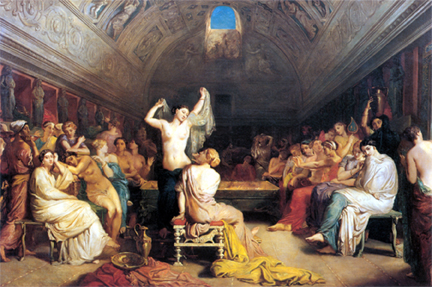 1
1The Lure of Italy
As the excavations around the bay of Naples became increasingly romanticised in paintings such as Théodore Chassériau's sexualised depiction of the Tepidarium of the Baths in Pompeii, Herculaneum and Pompeii became an essential part of the Grand Tour (fig.1). Naples provided the perfect point of departure. Not only was it one of the largest European cities after London and Paris, but its bay provided stunning views of Vesuvius, the only active volcano on mainland Europe.
Many of the early “tourists” were either connoisseurs, artists, architects or designers and accounts of their experiences encouraged future generations of cultural tourists. At the same time they also created yet more filters through which the ancient remains were viewed. The artists and scholars who went on the Grand Tour were directly responsible for introducing Neoclassicism into the visual culture of northern European. Cesare de Seta described this disparate band of cultural travelers as the “...largest and most independent wandering ‘academy’ that western civilisation has ever known.” (Grand Tour: The Lure of Italy in the Eighteenth Century, (eds) Wilton and Bignamini, 1996: 13) Scholarly books such as Sir William Gell’s Pompeiana: The Topography, Edifices, and Ornaments of Pompeii, with illustrations by J. P. Gandy, published in London in 1817, provided material for popular guide books used by the many hundreds of travellers who visited the excavations as part of their Grand Tour (fig.2&3). Some went more willingly than others. As early as 1763 Stendhal described seeing hundreds of young English undergraduates in Paris en route to Italy, where they were ‘obliged’ to study its antiquities. Inevitably the tendency for tourists to romanticise cultural history heaped yet more fact, faction and fiction upon the ruined cities. Today's tourists can visit Pompeii at night and have it ‘brought to life’ via the magic of son et lumière.
By the time Pompeii and Herculaneum emerged from the debris Vesuvius heaped upon them, Rome already had a well-established tourist industry. As early as 1705 pocket-sized guidebooks such as Joseph Addison’s (1672-1719) Remarks on Several Parts of Italy encouraged people to experience its antiquities. Rome’s still visible monuments and its near mythical status at the centre of a once great Empire inhabited by ‘superhuman beings’, was particularly prone to romanticised guidebook rhetoric. After his 1803-4 Grand Tour the French writer François-René de Chateaubriand (1768-1848), described Rome's ruins as simultaneously evoking glory and poignancy. ‘The man who occupies himself solely in the study of antiquities and the fine arts, or he who has no other ties in life, should live in Rome. The very stone that he treads on will speak to him; the dust blown by the wind around him will be decomposed particles of some great human being.’ (on the psychology and romanticisation of ruins see Christopher Woodward, In Ruins, Chatto and Windus: London, 2001.)
Like Chateaubriand, most visitors went to Rome or Pompeii in search of an idyllic fantasy, usually predicated upon a poetic vision of a lost Golden Age. Shepherds tending their flocks by moonlight, amongst the ruins of once great buildings, was all that was required to recreate this poetic vision. Even the fact that the duration of the visits made by these early tourists, unlike their modern counterparts, lasted from six weeks to several years did not undermine the mythical romance that they went in search of. Quite the opposite, they had the time to orchestrate their itineraries in order to produce the desired experience.
|
|